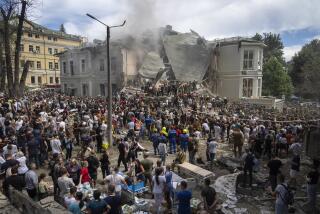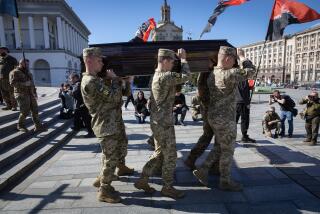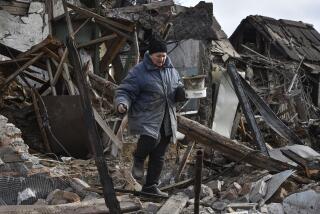Time Is Not on the Side of U.S., Allies
WASHINGTON — As the bombardment of Yugoslavia began Wednesday, U.S. and allied officials were hoping for a quick end to a job they know will only get tougher--and riskier--with each passing day.
In the first few days, NATO cruise missiles and warplanes--which Wednesday included B-2 Stealth bombers--will attack primarily high-value targets that are mostly easy to find, including command and communications centers, integrated air-defense systems, weapons factories and military storage sites.
NATO went after those targets with intense firepower during the first sorties in hopes of swiftly destroying some of Yugoslav President Slobodan Milosevic’s most important military assets.
Yet if there isn’t a capitulation in a few days by Milosevic, who has resisted international pressure for a negotiated peace settlement in the rebellious Serbian province of Kosovo, these targets will be mostly gone. Then NATO warplanes will face the frustrating job of destroying smaller, mobile and easy-to-conceal targets, including tanks, artillery, antiaircraft missiles and ground troops.
In this event, NATO pilots may be more at risk and Milosevic in a better position to settle in for a long fight, while hoping Western patience gives out before his troops do.
Officials are not looking forward to the second act with much enthusiasm.
“We’re prepared to hang in there,” acknowledged one defense official. “But time isn’t completely on our side.”
The North Atlantic Treaty Organization’s desire to hit hard and get it over with seemed apparent in the first night of strikes.
Though NATO officials had said Tuesday that they planned to use only the low-risk and relatively low-punch cruise missiles in the first day or two, they instead also deployed radar-evading F-117s and two B-2 bombers in their early airstrikes.
The two California-built B-2s, which had never before been used in combat, left Whiteman Air Force Base in Missouri on Tuesday for a round trip to Yugoslavia, each carrying a cargo of 16 satellite-guided bombs. The $2.1-billion bombers are refueled in midair.
And defense officials acknowledged as well that, contrary to some earlier indications, NATO fighter planes were involved over Yugoslavia in the first sorties. They said at least two Yugoslav MIG-29 fighters were downed.
Even as the airstrikes started, defense officials offered two scenarios that might cause Milosevic to return to the bargaining table. Under one theory, Milosevic may find it politically possible to permit peacekeeping troops in Kosovo--a key element of peace talks that he has been resisting--now that he has the political cover provided by the airstrikes. The second theory holds that Milosevic will relent when the NATO attacks put him under pressure from his own army.
However, NATO officials also acknowledge that, in any case, capitulation could take some time. Meanwhile, they are committed to trying to grind down his forces.
Gen. Henry H. Shelton, chairman of the Joint Chiefs of Staff, said Wednesday that NATO would continue to attack “the full range of his military capabilities” if Milosevic did not end the Yugoslav offensive against towns in Kosovo, where rebels are seeking self-determination for the province’s ethnic Albanian majority.
NATO hopes to knock out, in the early stages of the air campaign, the surface-to-air missile batteries that threaten the alliance’s planes.
This may not prove so easy: The best of these--SA-6 batteries--are mobile and can be concealed in the rugged terrain of Kosovo, particularly under the cover provided by the frequently foggy and cloudy conditions that characterize the region.
And Yugoslav forces have countless smaller shoulder-launched surface-to-air missiles, as well as antiaircraft batteries. These can reach only a limited altitude, usually far lower than most NATO warplanes will fly.
Yet the SA-6s can threaten higher-flying NATO planes. And the less sophisticated missiles can threaten the A-10 Thunderbolt attack aircraft, a tank-destroying plane that NATO could bring in from a base in Aviano, Italy.
The A-10s were effective during the Persian Gulf War in “plinking,” or attacking, tanks. Yet they must fly to lower altitudes, putting their pilots at greater risk.
(BEGIN TEXT OF INFOBOX / INFOGRAPHIC)
Serbian Missile Defense
The first wave of NATO strikes is aimed at heavily damaging Yugoslavia’s air-defense network, which consists of mobile and stationary units using a range of Russian-built missiles.
Type of missle
SA-2: Medium range
SA-3: Low to medium range
SA-5: Medium to high range
SA-6: Low to medium range
SA-11: Low to medium range
Typical surface-to-air missle coverage area.
Missle loses energy as it climbs, but there is less air resistance at higher altitudes.
Missle has some maneuverability at all ranges.
Missle has a higher probability of hitting its target in this area.
Type of missle and range
SA-5
SA-2, SA-3, SA-6, SA-11
Source: Federation of American Scientists
More to Read
Sign up for Essential California
The most important California stories and recommendations in your inbox every morning.
You may occasionally receive promotional content from the Los Angeles Times.











